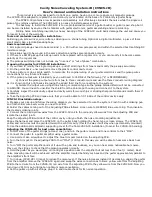
9
For example, suppose you connect an 8-ohm speaker to the Main speaker jack, and
connect another 8-ohm speaker to the Extension speaker jack. When you connect two
8-ohm speakers in parallel, the total combined impedance is 4 ohms, so you would set
the Impedance switch to 4 ohms.
Calibration (test jacks, screen adj, bias adj)
Calibration (test jacks, screen adj, bias adj)
Calibration (test jacks, screen adj, bias adj)
Calibration (test jacks, screen adj, bias adj)
The test jacks and calibration trimmers in this section of the back panel are used to
calibrate the screen grid voltage and the bias current of the output tubes. The
calibration procedure is described in detail in its own section of this manual
Effects Loop (Send, Receive)
Effects Loop (Send, Receive)
Effects Loop (Send, Receive)
Effects Loop (Send, Receive)
The effects loop is a tube-buffered series loop. It is designed to be used with either
standard footpedals or rack mount effects. The front panel “FX Bypass” switch can be
used to bypass the loop, and should be set in the Bypass position if you are not using
the loop.
The “Send” jack should be connected to the Input of your effects device. The “Receive”
jack should be connected to the Output of your effects device. Both connections should
be made with a ¼” mono instrument cable.
For best results, you should only use effects such as (delay, chorus, phaser, reverb,
flanger) in the effects loop. Any type of overdrive or distortion effect will work best
when connected between the guitar and the Instrument input jack of the amp (not in
the loop).
Your chain of effects is expected to have unity gain (meaning that the output level is the
same as the input level). The effects devices must NOT add or subtract gain, or the
balance of gain within the amp will be changed, and the sound of the amp will be
compromised. When using the effects loop, try toggling the FX BYPASS switch on the
front panel back and forth, and adjusting your effects devices so that the signal level
remains the same when enabled as when bypassed.
Line Out (Output, Level)
Line Out (Output, Level)
Line Out (Output, Level)
Line Out (Output, Level)
The line-out signal is generated from the speaker output, and is conditioned so that the
signal level is appropriate for driving the a line level input such as a mixing board,
computer sound card, headphone amplifier, or the input of another guitar amplifier.
Because it is generated from the speaker output, it retains the sound of the amplifier
quite well.
It is possible to operate the amp without a speaker connected, and to use only the
signal coming from the line-out jack. In order to do this, simply turn the attenuation
control (on the front panel) to the –36db setting, and unplug all speakers from the
speaker jacks. It is perfectly safe to operate the amplifier like this. The output stage
will be properly loaded by the reactive load circuit of the attenuator, and there is no risk
of damaging the amplifier in any way.



































